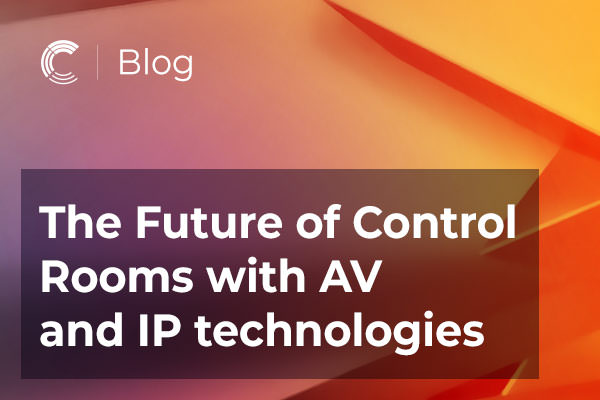
When AV meets IT: how to get integrations to work
May 14th, 2020
Audio-visual (AV) equipment has changed substantially over the past couple of years. Evolving from standalone devices such as overhead projectors and speakers, into a networked IT ecosystem. Largely, the rise of sophisticated AV solutions has been driven by the popularity of video communication as well as the increasing demand and requirements for enterprise conferencing and collaboration tools.
When coupled with the increasing availability of interactive screens and video walls, it’s easy to see why AV technologies continue to saturate our working environments. From large corporate boardrooms and digital signage to more nimble huddle spaces, enterprises often look towards AV as a way to create engaging experiences and facilitate real-time interactions.
The importance of AV
The move to IP-based systems is well underway, as many organisations look to stream audio and video content over their existing Ethernet networks. AV over IP delivers end users and network operators with substantial opportunities for cost savings, scalability and ease of use. The industry switch from traditional AV to IP-based connectivity also provides the opportunity to utilise better-quality content through high definition video. Delivering this level of content in real-time requires an AV-over-IP infrastructure to enable high-speed scalable networks that meet demand.
For AV integrators, the process is much less time-consuming and inexpensive than traditional AV. Time spent having to run dedicated cables from the control processor to each individual piece of equipment, have been removed. As has the lengthy process of pulling cables, terminating connectors and subsequent testing. Instead, AV-over-IP is much easier to upscale and enables the connection of multiple IP switches to expand the set up. There is also better ratio of inputs to outputs, video standards have more potential and there are more options available in video processing.
AV and IT integration
However, the AV/IT convergence also presents business challenges. System design is one area which requires some careful consideration. Creating a separate Virtual Local Area Network (VLAN) for AV devices is the preferred route to take. This way AV professionals have some control over the network setup, although ultimately it will be under the management of the networks team. The main advantage of this setup is that essential updates and security patches are managed and controlled by a dedicated specialist team.
Alternatively, in a standalone network scenario it is likely that the AV integrator will have supplied the network, giving organisations full control over what is placed on it and maintenance of the network appliances. This is typically used in smaller single room applications where the main job of the network is to control the AV system.
Whether the approach is to keep AV segregated from non-AV traffic and on its own closed network – or alternatively, use existing infrastructure. It’s important that IT departments understand how to best support AV, whatever network it’s on.
Fine-tuning your IT strategy
No two network configurations are the same, so it’s imperative that all IT specialists are involved from the outset. It’s also worth understanding how the IT function is organised. In some cases, it’s one department that does everything but more often than not, the IT department is segmented into specialist functions such as security, networking and desktop. Knowing the key people in each speciality is an important part of delivering a successful project. Not involving IT staff and keeping AV ‘invisible’ to IT managers only leads to a fragmented approach.
While the need for IT to effectively manage the entire AV estate has grown in importance, AV experts are still vital. IT managers aren’t suddenly expected to become proficient in video calibration, microphone or display setup.
Instead, AV and IT professionals need to work together and forge partnerships that allow them to extend their knowledge. Some organisations will have the resources in-house to drive this while others will look for external integration. Regardless, it’s important that both teams set out best practice guidelines and share technical experience and expertise. In doing so, it will enable them to meet user expectations and deliver consistent and easy to use audio-visual experiences.
Additionally, it’s worth pointing out that when it comes to new building projects, the earlier AV can get involved, the better. Leaving it too late limits the scope of the products that can be implemented and often leads to a disjointed approach. The most successful projects are those where AV is embraced in the early stages, so that it can effectively be designed and implemented into new buildings from the beginning.
A guide for best practice
Many businesses have a well-defined IT strategy built on experience, international standards and best practice. AV equipment that aligns with these standards and adopts these best practices are of equal importance as the functionality the AV device might provide.
Service availability has always been high on the list for the IT function, monitoring the performance and availability of systems is commonplace and the ability to monitor AV devices should be of equal importance. Many AV manufacturers provide their own bespoke monitoring solution often unique to their products. Whilst this may be fine in some situations, it does contribute to the number of applications the service and support team have to monitor. Devices that adopt standards-based monitoring protocols might be a better optionas they provide the business with the ability to view the network health and supporting components, through a familiar monitoring solution.

Effective project management
The adoption of AV-over-IP is a two-way street, it isn’t just about how the AV integrates with IT but also about IT changing and adapting processes for AV. Conflict is becoming less of a problem as home AV services such IPTV, streamed video and networked control devices are becoming more prevalent. This means that IT departments are generally more accepting of the technology. However, the ‘it works at home’ attitude won’t translate to an enterprise environment – as it doesn’t consider scaling a solution, security and uniqueness of the office network. Ultimately, the key to a successful AV/IT convergence project is to view it as a business process and not just technology.




